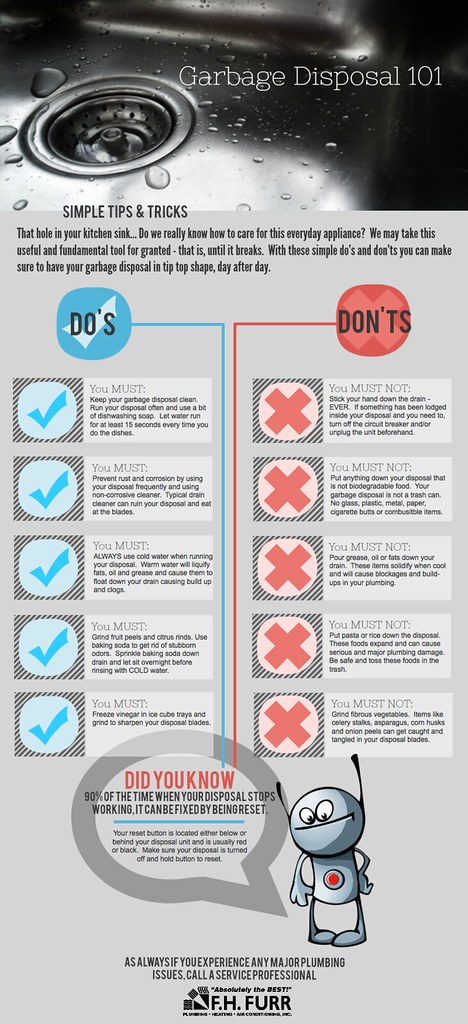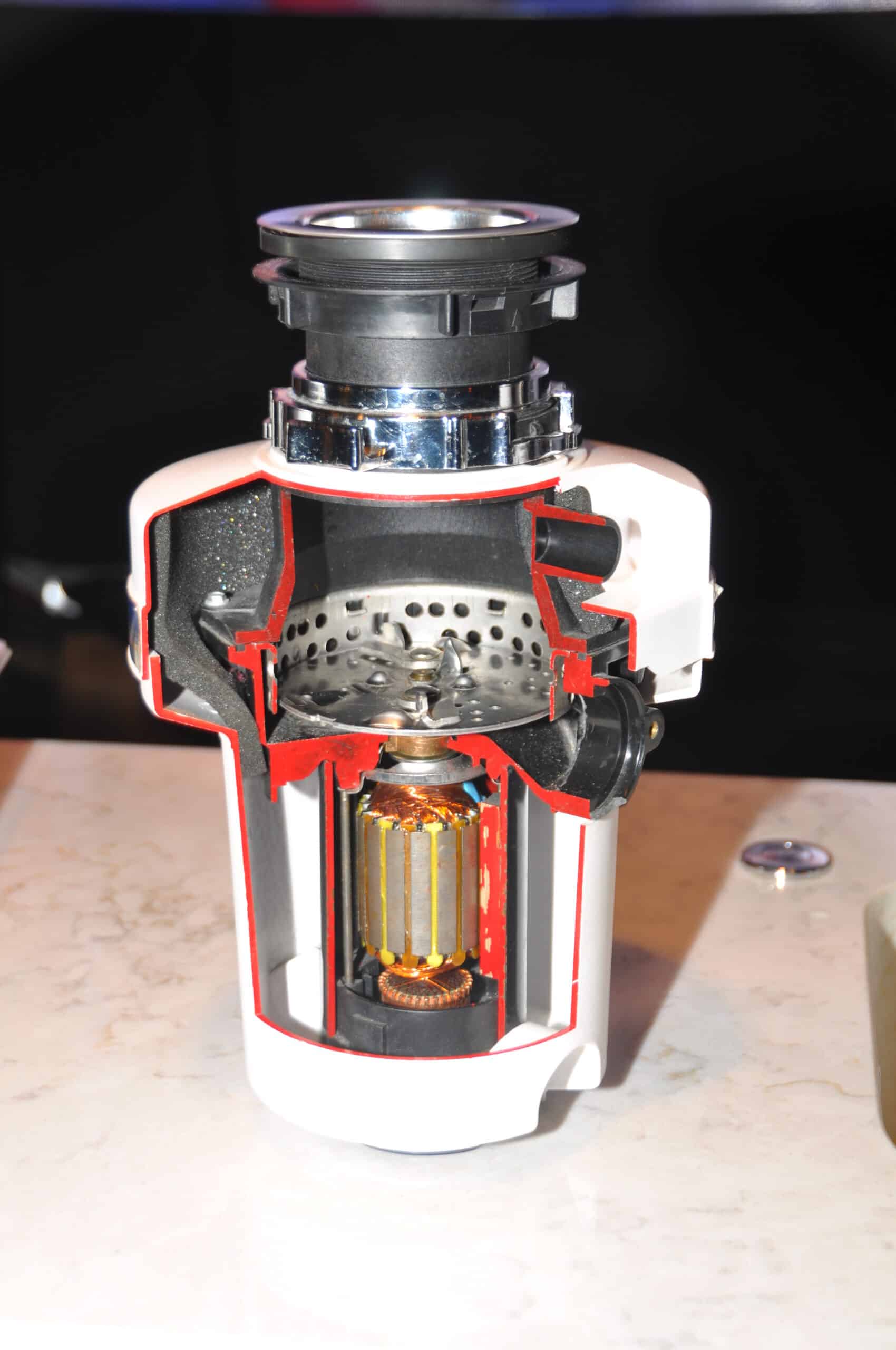How does a garbage disposal work?
Ever wondered what happens to food scraps when you flip that switch under your kitchen sink? Your garbage disposal is working hard behind the scenes, transforming food waste into tiny particles that flow safely through your plumbing system. Understanding how this essential kitchen appliance operates can help you use it more effectively and avoid costly repairs.
This guide breaks down the inner workings of your garbage disposal unit, explains the two main types available, and provides essential tips for proper usage and maintenance.

“FH Furr’s Garbage Disposal 101” by FHFurr is licensed under CC BY 2.0
What Is a Garbage Disposal?
A garbage disposal is a motorized appliance installed beneath your kitchen sink that grinds food waste into small particles. These tiny particles mix with water and flow through your plumbing system to wastewater treatment plants, reducing the amount of household waste that ends up in landfills.
The disposal unit connects directly to your sink drain and requires both electrical power and cold water to function properly. When you feed food waste into the grinding chamber, the motor spins a grinding assembly that breaks down food scraps into particles small enough to pass through your pipes without causing clogs.
Benefits of Maintaining Your Garbage Disposal
Proper maintenance of your garbage disposal comes with a host of benefits that can improve your kitchen’s functionality and your overall home environment. Here are some key advantages:
1. Prevents Clogs and Blockages
Regular cleaning and proper usage help to prevent food waste and debris from building up in your disposal and pipes. This reduces the likelihood of clogs, which can disrupt your kitchen’s functionality and require costly plumbing repairs.
2. Extends Appliance Lifespan
A well-maintained garbage disposal is likely to last much longer than one that is neglected. Routine care minimizes wear and tear on the blades and motor, ensuring your unit remains effective and reliable over time.
3. Reduces Unpleasant Odors
Food particles trapped in the garbage disposal can lead to unpleasant smells if not properly handled. By maintaining your unit and keeping it clean, you prevent foul odors from developing and keep your kitchen smelling fresh.
4. Promotes Hygiene
A clean garbage disposal limits the growth of bacteria and mold that can result from decaying food waste. Proper maintenance thus contributes to a more sanitary and healthy kitchen environment.
5. Improves Grinding Performance
Routine upkeep ensures the blades remain sharp and efficient, allowing your disposal to grind food waste effectively. This not only prevents blockages but also makes disposal quieter and smoother to operate.
6. Saves Money in the Long Run
Investing time in proactive maintenance helps you avoid expensive repairs or replacement costs. It ensures your garbage disposal runs efficiently, preventing costly plumbing or appliance issues.
By taking simple steps to maintain your garbage disposal, you can enjoy a cleaner, more functional kitchen, while also saving money and reducing stress in the long term.

“Ria in the kitchen sink” by sunside is licensed under CC BY-NC-ND 2.0
The Two Main Types of Garbage Disposals
Continuous Feed Models
Continuous feed disposals are the most common type found in homes. These units operate with a wall switch that turns the motor on and off. You can add food scraps while the disposal is running, making them convenient for handling large amounts of food waste during meal preparation.
With continuous feed models, you simply turn on the cold water, flip the switch, and gradually feed food waste into the grinding chamber. The disposal continues running until you turn it off, allowing you to process food scraps continuously.
Batch Feed Models
Batch feed disposals offer enhanced safety features and operate differently from continuous feed units. Instead of a wall switch, these models use a special stopper that covers the drain opening. The disposal only runs when this stopper is properly positioned and turned.
You load food scraps into the grinding chamber, cover it with the stopper, and turn the stopper to activate the motor. This design prevents accidental operation and reduces the risk of objects falling into the disposal while it’s running.
How the Grinding Process Works
The Motor and Grinding Assembly
The heart of your garbage disposal is an electric motor that typically ranges from 1/3 to 1 horsepower. This motor connects to a motor shaft that spins a grinding assembly inside the grinding chamber.
Contrary to popular belief, garbage disposals don’t use sharp blades. Instead, they employ a grinding system with impellers (also called lugs) mounted on a spinning plate. These impellers work with a stationary grind ring (or shredder ring) mounted on the chamber wall.
The Grinding Action
When you feed food waste into the disposal, centrifugal force throws the food scraps against the grind ring. The spinning impellers push food particles against this stationary ring, which has sharp edges that shred the waste into small pieces.
The grinding chamber is designed to keep food particles circulating until they’re small enough to pass through holes in the grind ring. Only particles tiny enough to flow through your plumbing system can exit the disposal.
Step-by-Step Operation Process
Before You Start
Always run cold water before turning on your garbage disposal. Cold water helps solidify grease and fats, making them easier to grind and preventing them from coating your pipes as they travel through the plumbing system.
During Operation
- Turn on the cold water and let it run steadily
- Activate the disposal using the wall switch (continuous feed) or stopper mechanism (batch feed)
- Gradually feed food scraps into the grinding chamber
- Allow the disposal to run until grinding stops and the motor sounds smooth
- Continue running water for 10-15 seconds after turning off the disposal
After Grinding
Keep the water running after the grinding stops to flush all particles through your pipes. This final flush helps prevent food particles from settling in your plumbing system and causing clogs.
What You Can and Cannot Put in Your Disposal
Safe Food Waste
Your garbage disposal can handle most soft food scraps, including:
- Fruit and vegetable peels (except fibrous items)
- Small amounts of cooked meat
- Soft food particles
- Citrus peels (which can help freshen the unit)
- Ice cubes (which can help clean the grinding chamber)
Items to Avoid
Certain materials can damage your disposal or cause plumbing problems:
- Fibrous foods: Corn husks, celery stalks, and onion skins can wrap around the grinding assembly
- Hard items: Fruit pits, bones, and shells can damage the grinding components
- Grease and fats: These can solidify in pipes and cause clogs
- Non-food items: Metal, plastic, glass, and other materials can seriously damage the unit
- Large amounts of food: Feed waste gradually to avoid overwhelming the system
Maintenance Tips for Optimal Performance
Regular Cleaning
Clean your disposal regularly to prevent foul odors and maintain proper operation. Run cold water and grind ice cubes to remove buildup from the grinding chamber. You can also use citrus peels to freshen the unit naturally.
For deeper cleaning, turn off the power and use a mixture of baking soda and vinegar. Pour the baking soda down the drain, followed by vinegar, and let it fizz for a few minutes before flushing with cold water.
Preventing Unpleasant Odors
Food particles can accumulate in the grinding chamber and create unpleasant odors. Regular cleaning and proper use help prevent this problem. Always run plenty of water when using the disposal, and avoid putting grease or large amounts of food waste down the drain.
When to Call a Professional
If your disposal stops working, makes unusual noises, or frequently clogs, it may need professional attention. Common issues include motor problems, worn grinding components, or plumbing system blockages that require specialized equipment to resolve.
Troubleshooting Common Problems
Disposal Won’t Turn On
Check that the unit is plugged in and the circuit breaker hasn’t tripped. Many disposals have a reset button on the bottom of the unit that may need to be pressed.
Grinding Stops During Operation
If the grinding stops suddenly, turn off the disposal and check for jammed objects. Never put your hand in the disposal – use tongs or pliers to remove visible obstructions.
Water Backs Up in the Sink
This usually indicates a clog in the P-trap or drain line. Try running the disposal with plenty of cold water. If the problem persists, you may need professional drain cleaning services.
Garbage Disposal Cleaning Products
Glisten Disposer Care Freshener & Cleaner
Glisten is a trusted brand that provides an effective foaming cleaner to remove odors and buildup. Its lemon-scented formula leaves your disposal fresh and clean. Purchase here
Affresh Garbage Disposal Cleaner
Affresh offers easy-to-use biodegradable tablets that clean and eliminate odors. They effectively tackle grime and residue inside your disposal system. Purchase here
Plink Garbage Disposal Freshener and Cleaner
Plink is perfect for both cleaning and deodorizing your disposal. Its small capsules dissolve grease and leave behind a pleasant citrus scent. Purchase here
Lemi Shine Disposal Cleaner
Powered by natural citric extracts, Lemi Shine’s cleaner removes hard water buildup and odors with a non-toxic, eco-friendly approach. Purchase here
Seventh Generation Lemongrass & Citrus Cleaner
Seventh Generation offers a plant-based, environmentally responsible option that effectively cleans without harsh chemicals, leaving a natural refreshing scent. Purchase here
Weiman Garbage Disposal Cleaner and Deodorizer
Weiman’s cleaner uses foaming action to reach deep, degrease, and sanitize hard-to-reach areas of your garbage disposal system. Purchase here
GAEPlumbing&Heating will handle all of your garbage disposal services, repairs, and replacements. Contact us today!
Making the Most of Your Kitchen Appliance | How Does A Garbage Disposal Work?
Understanding how your garbage disposal works helps you use it more effectively and extend its lifespan. Remember that proper usage involves feeding small amounts of appropriate food waste while running cold water, and avoiding items that can damage the grinding mechanism or cause plumbing problems.
Your garbage disposal is designed to handle everyday food scraps, but it’s not a substitute for proper food waste disposal practices. By following these guidelines and maintaining your unit properly, you can enjoy the convenience of this essential kitchen appliance for years to come.
For complex garbage disposal installation or repair needs, consider consulting with experienced plumbing professionals who can ensure your unit operates safely and efficiently within your home’s plumbing system.


